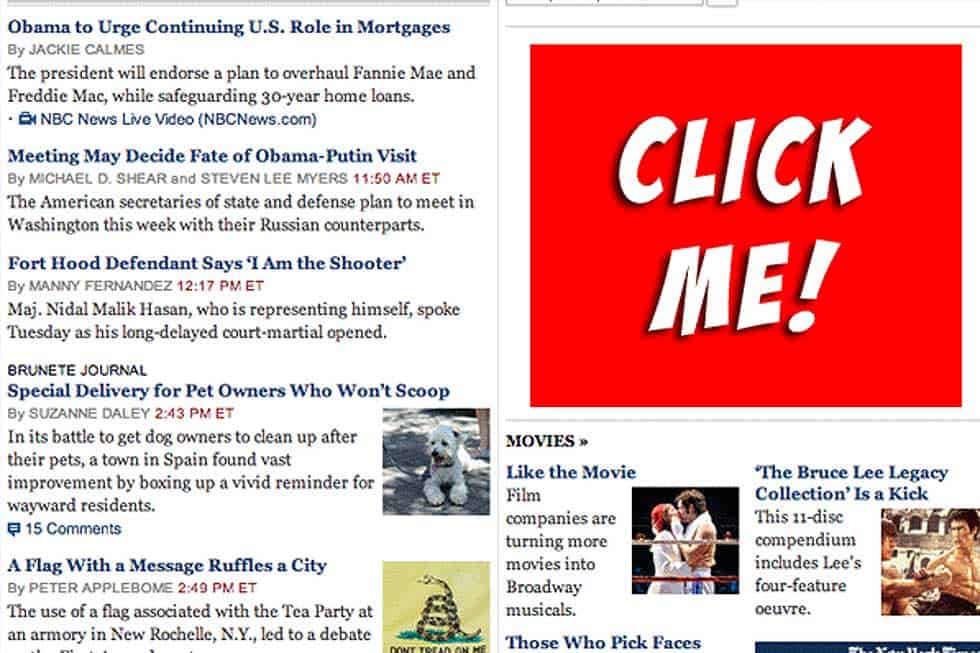
Internet display advertising is exploding in popularity among businesses and online marketers. The volume of impressions generated by sites like YouTube and Facebook, along with networks like Google and Bing, create enticing opportunities to advertise to millions of people. However, the question remains: do display ads really convert?
How it Works
Display ads are typically created by graphic designers in a variety of sizes (most popular are medium and large rectangle, leaderboard and skyscraper) and may include branded images, taglines and messages.
Display advertising, like traditional print advertising, relies on a CPM (cost per one thousand impressions) model. Marketers set budgets based on demographic research and keyword analysis, with hopes of targeting highly qualified consumers who will click their ads and turn into leads or customers.
CPM pricing is driven by multiple variables. As a rule of thumb, popular websites with a lot of traffic cost more to display on. Also, larger ads being placed in more visible areas are in higher demand and cost more to obtain. As an example, buying an ad in the header of the New York Times homepage will cost a fortune, due to the volume of site traffic and ad placement.
The Benefits of Display
Properly executed display ads are matched to the type of content a user is consuming. Visiting ESPN’s Golf section, for example, may trigger ads for Ping golf clubs or Macanudo Cigars. This one-to-one relationship alleviates the aggravation of being sabotaged with unrelated ads that detract from the experience of online browsing.
Additionally, new types of display advertising, such as retargeting (ads that follow you after leaving a website) allow ads to be served to searchers who have already shown intent. You’ve probably noticed brands like Zappos implementing this to perfection. If you put a pair of size 12 Nike basketball shoes in your cart, but leave the site without checking out, Zappos will more than likely serve you ads on future sites you visit, reminding you of your interest in their product.
The Downside
A recent study done by HubSpot pointed out the following trappings of display advertising:
1. The average person is served over 1,700 banner ads per month.
2. The average clickthrough rate of display ads is 0.1%.
3. About 50% of clicks on mobile ads are accidental.
The main grudges against display, are that many advertisers do not take care in matching ads with search intent and that people are flooded with so many ads they have subconsciously trained themselves to ignore them. Many ads fall into “blind spots” that users have learned to visually avoid, due to their expectation of seeing ads there. This means while an ad may be recorded as an “impression”, there’s no guarantee a user actually saw it. This skews analytics data and makes it very difficult to weight return on investment.
The Verdict: Are Display Ads a Good Investment?
It’s no secret that display ads generate more impressions than paid search but get a quarter of the clicks. That being the case, marketers need to stop pitching display as a conversion and/or acquisition tool. Display is best used to increase brand recognition and customer loyalty. Just like a billboard on a highway, many will see a display ad but the chances of it leading to direct action are slim. However, the visual nature of display has the potential to burn a lasting image into the minds of consumers.
Brand recognition is incredibly important for businesses of all sizes. Display advertising allows businesses to stay top of mind and consistently remind consumers of their presence in the marketplace. When paired with other forms of online marketing, it becomes even more powerful. You may not convert someone with a display ad, but your SEO and PPC campaigns can help to augment your expenditure. A well planned integrated marketing strategy will help you find the right balance and make the best use of your advertising budget.
Let`s Get
In Touch
Contact us today for a free consultation
and cost estimate for
your project.
We work with companies in all
industries, big or small.
Give Us a Call: 786-529-6039
Services
©2024 FUZE DIGITAL INC. Ignite Your Brand™ | privacy





